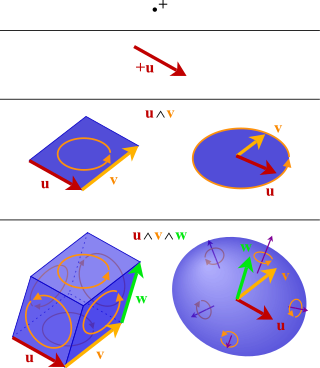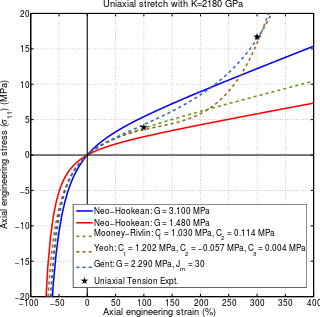Definition
Given a positive integer  , the notation
, the notation  refers to the set
refers to the set  of the first M positive integers.
of the first M positive integers.
For each integer  where
where  for a positive integer
for a positive integer  , let
, let  denote an
denote an  -dimensional vector space over a field
-dimensional vector space over a field  . Then there are vector space isomorphisms (linear maps)
. Then there are vector space isomorphisms (linear maps)

where  is any permutation and
is any permutation and  is the symmetric group on
is the symmetric group on  elements. Via these (and other) vector space isomorphisms, a tensor can be interpreted in several ways as an order-
elements. Via these (and other) vector space isomorphisms, a tensor can be interpreted in several ways as an order- tensor where
tensor where  .
.
Coordinate representation
The first vector space isomorphism on the list above,  , gives the coordinate representation of an abstract tensor. Assume that each of the
, gives the coordinate representation of an abstract tensor. Assume that each of the  vector spaces
vector spaces  has a basis
has a basis  . The expression of a tensor with respect to this basis has the form
. The expression of a tensor with respect to this basis has the form

where the coefficients  are elements of
are elements of  . The coordinate representation of
. The coordinate representation of  is
is

where  is the
is the  standard basis vector of
standard basis vector of  . This can be regarded as a M-way array whose elements are the coefficients
. This can be regarded as a M-way array whose elements are the coefficients  .
.
General flattenings
For any permutation  there is a canonical isomorphism between the two tensor products of vector spaces
there is a canonical isomorphism between the two tensor products of vector spaces  and
and  . Parentheses are usually omitted from such products due to the natural isomorphism between
. Parentheses are usually omitted from such products due to the natural isomorphism between  and
and  , but may, of course, be reintroduced to emphasize a particular grouping of factors. In the grouping,
, but may, of course, be reintroduced to emphasize a particular grouping of factors. In the grouping,

there are  groups with
groups with  factors in the
factors in the  group (where
group (where  and
and  ).
).
Letting  for each
for each  satisfying
satisfying  , an
, an  -flattening of a tensor
-flattening of a tensor  , denoted
, denoted  , is obtained by applying the two processes above within each of the
, is obtained by applying the two processes above within each of the  groups of factors. That is, the coordinate representation of the
groups of factors. That is, the coordinate representation of the  group of factors is obtained using the isomorphism
group of factors is obtained using the isomorphism  , which requires specifying bases for all of the vector spaces
, which requires specifying bases for all of the vector spaces  . The result is then vectorized using a bijection
. The result is then vectorized using a bijection  to obtain an element of
to obtain an element of  , where
, where  , the product of the dimensions of the vector spaces in the
, the product of the dimensions of the vector spaces in the  group of factors. The result of applying these isomorphisms within each group of factors is an element of
group of factors. The result of applying these isomorphisms within each group of factors is an element of  , which is a tensor of order
, which is a tensor of order  .
.
Vectorization
By means of a bijective map  , a vector space isomorphism between
, a vector space isomorphism between  and
and  is constructed via the mapping
is constructed via the mapping  where for every natural number
where for every natural number  such that
such that  , the vector
, the vector  denotes the ith standard basis vector of
denotes the ith standard basis vector of  . In such a reshaping, the tensor is simply interpreted as a vector in
. In such a reshaping, the tensor is simply interpreted as a vector in  . This is known as vectorization, and is analogous to vectorization of matrices. A standard choice of bijection
. This is known as vectorization, and is analogous to vectorization of matrices. A standard choice of bijection  is such that
is such that

which is consistent with the way in which the colon operator in Matlab and GNU Octave reshapes a higher-order tensor into a vector. In general, the vectorization of  is the vector
is the vector  .
.
The vectorization of  denoted with
denoted with  or
or  is an
is an  -reshaping where
-reshaping where  and
and  .
.
Mode-m Flattening / Mode-m Matrixization
Let  be the coordinate representation of an abstract tensor with respect to a basis. Mode-m matrixizing (a.k.a. flattening) of
be the coordinate representation of an abstract tensor with respect to a basis. Mode-m matrixizing (a.k.a. flattening) of  is an
is an  -reshaping in which
-reshaping in which  and
and  . Usually, a standard matrixizing is denoted by
. Usually, a standard matrixizing is denoted by

This reshaping is sometimes called matrixizing, matricizing, flattening or unfolding in the literature. A standard choice for the bijections  is the one that is consistent with the reshape function in Matlab and GNU Octave, namely
is the one that is consistent with the reshape function in Matlab and GNU Octave, namely

Definition Mode-m Matrixizing: [1]

The mode-m matrixizing of a tensor  is defined as the matrix
is defined as the matrix  . As the parenthetical ordering indicates, the mode-m column vectors are arranged by sweeping all the other mode indices through their ranges, with smaller mode indexes varying more rapidly than larger ones; thus
. As the parenthetical ordering indicates, the mode-m column vectors are arranged by sweeping all the other mode indices through their ranges, with smaller mode indexes varying more rapidly than larger ones; thus







































































